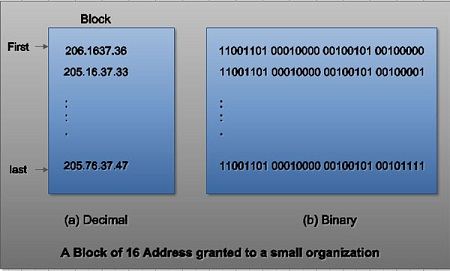• The fast growth of Internet led to the near depletion of the available addresses.
• We have run out of class A and B addresses, and a class C block is too small for most midsize organizations.
• To overcome the problem of address depletion and give more organizations access to internet, classess addressing was designed and implemented.
• In this scheme, there are no classes, but the addresses are still granted in blocks.
• In classless addressing, when an entity, small or large, needs to be connected to Internet, it is granted a block or range of addresses.
• The size of the block (the number of addresses) varies based on the nature and size of the entry. For example, a household may be given only two addresses; a large organization may be given thousands of addresses. An ISP, may be given thousands or hundreds of thousands based on the number of customer it may serve.
• To simplify the handling of addresses, the Internet authorities impose three restrictions on classless address blocks:
1. The addresses in a block must be contiguous, one after the other.
2. The number of addresses in a block must be a power of 2 (1, 2, 4,8, …. ).
3. The first address must be evenly divisible by the number of address.
• For example, a block of addresses (both in binary and dotted decimal notation) granted to a small business that needs 16 addresses.
• As shown in figure certain restrictions are applied to this block. The addresses are contiguous. The number of addresses is a power of 2 (16=24), and the first address is divisible by 16. The first address, converted to decimal number, is 3,440,387,360, which whet divided by 16 results in 215,024,210.

 Dinesh Thakur holds an B.C.A, MCDBA, MCSD certifications. Dinesh authors the hugely popular
Dinesh Thakur holds an B.C.A, MCDBA, MCSD certifications. Dinesh authors the hugely popular